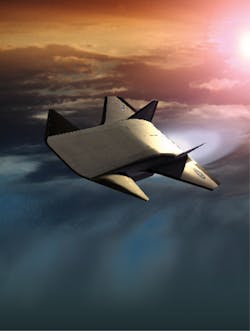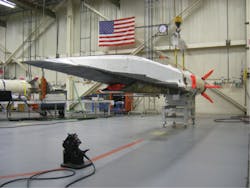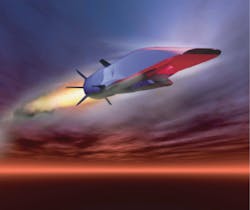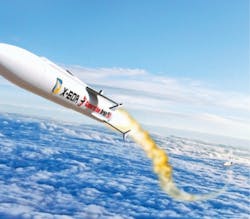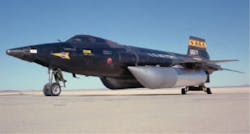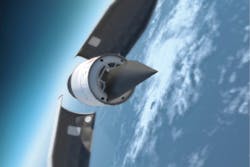The emerging world of hypersonic weapons technology
U.S. military leaders find themselves in a global technology race to develop hypersonic weapons able to travel at speeds faster than Mach 5, which requires research breakthroughs in electronics, thermal management, electronics, and command and control.
By J.R. Wilson
For most people, hypersonic weapons and aircraft represent yet another 21st century technology breakthrough in which science fiction becomes science fact. As with the vast majority of such “overnight” miracles, however, hypersonics have a long history, stretching back more than half a century. Just as with unmanned aerial vehicles (UAVs) at the same time, hypersonics languished in the lab largely due to military indifference.
To begin with, hypersonic refers to aircraft, missiles, rockets, and spacecraft that can reach speeds through the atmosphere faster than Mach 5, which is near 4,000 miles per hour.
“I believe we were well poised to attack this problem in the 1960s, with the X-15, which was a successful hypersonic vehicle,” says William Carter, program manager for the Materials Architectures and Characterization for Hypersonics (MACH) at the U.S. Defense Advanced Research Projects Agency (DARPA) in Arlington, Va.The North American X-15, was a rocket-powered hypersonic aircraft of the 1960s. Three of these research aircraft were built, and one of them set a world speed record 52 years ago that still stands — Mach 6.7, or 4,520 miles per hour, at an altitude of 102,100 feet.
“Aside from the NASP [National Aerospace Plane], there hasn’t been a strong national need to sustain research in this area,” Carter continues. “There was a lot more trial and error 50 years ago because we didn’t have the computing capabilities we have today.”
The U.S. Air Force played a major role in the NASP program, says James Miller, principal advisor to the High-Speed Systems Division of the Air Force Research Laboratory (AFRL) Aerospace Systems Directorate at Wright-Patterson Air Force Base, Ohio. Although it never was completed, the NASP program advanced many hypersonic technologies, including computational fluid dynamics, air-breathing propulsion, and high-temperature structures and materials.
“Following NASP, the Air Force focused on developing technologies to enable hypersonics for a range of applications, with weapon concepts representing the near-term application,” Miller says. “The Air Force developed a scramjet engine that burned liquid hydrocarbon fuel [JP-7]. This was flight tested on the X-51 Scramjet Engine Demonstrator — Waverider — which flew four times between 2010 and 2013. This proved the viability of a scramjet-powered vehicle for weapon applications. The Air Force has been leading in developing technologies for a High-Speed Strike Weapon (HSSW) to enable a responsive, long-range strike capability via a partnership with DARPA.”
Withstanding high temperatures
Today active research and development is in progress on all aspects of hypersonic flight, from materials to withstand high temperatures generated in the atmosphere, to more efficient propulsion systems, to size, weight and power (SWaP)-constrained enhanced electronics for sensors, guidance, communications, and other harsh-environment applications. Space programs have used many of those for decades to protect spacecraft re-entering the atmosphere at hypersonic speeds.
“The community is responding tremendously and the number of young, early-career engineers who have expressed interest in hypersonics is very encouraging,” DARPA’s Carter says. “I hope we will see the emergence of a community very much like what we had back then [the 1960s], but informed by the new computing capabilities and materials science capabilities we have today, fueled by the American entrepreneurial spirit.”Advances in technology, especially since the turn of the century, have improved greatly on what was possible half a century ago. The need for such capabilities also has grown substantially.
“There have been significant advances in computational fluid dynamics, air-breathing propulsion, and high-temperature structures and materials. Current efforts are using advanced design and manufacturing techniques. Cost is an important factor that has received significant emphasis in the current generation of programs. And, finally, the need for hypersonic systems is emerging and maturing,” AFRL’s Miller says.
“Hypersonics is one of the game-changer technology areas that provide high-speed options for engaging time-sensitive targets and improving the survivability of our systems,” Miller continues. “Hypersonics amplifies many of the enduring attributes of air power — speed, range, flexibility, and precision. Systems that operate at hypersonic speeds offer the potential for military operations from longer ranges with shorter response times and enhanced effectiveness compared to current military systems. Such systems could provide significant capabilities for future U.S. operations, particularly as adversaries’ capabilities advance.”
The new foothold hypersonic research has gained in military, academic, and industrial labs in recent years has not been limited to the United States, but also has grown significantly in Europe and the Asia/Pacific region — especially China and Russia. Both of those old adversaries, who are challenging America’s technological lead, have boasted of great advances in hypersonics and their intentions to field operational aircraft and weapons in the near future.
Hypersonics technology race
While there is considerable debate over the validity of Russian and Chinese claims, some of America’s top military officers say there is enough evidence to make dismissing them a serious mistake. That is especially true regarding China, which Air Force Gen. Paul J. Selva, vice chairman of the Joint Chiefs of Staff, says has made hypersonics a Manhattan Project-level operation on which they are willing to spend “up to hundreds of billions to solve the problems of hypersonic flight, hypersonic target designation, and then, ultimately, engagement.”
For example, in March 2018, China’s state media announced construction on an 870-foot wind tunnel capable of simulating conditions from Mach 10 to Mach 25. Scheduled for completion in 2020, it will join existing wind tunnels able to simulate environments from Mach 5 to Mach 9. The U.S., by comparison, has Mach 5 to Mach 9 wind tunnels, but they are smaller than the Chinese tunnels, and capable of tests lasting only a few seconds.That same month, Russian President Vladimir Putin announced testing on the Kinzhal missile, which he claims can reach Mach 10 speeds, carrying conventional or nuclear warheads, while impervious to existing or prospective air and missile defenses.
At a Colorado space conference in April 2018, Air Force Gen. John E. Hyten, currently head of the U.S. Strategic Command and recently nominated to succeed Selva on the Joint Chiefs of Staff, told reporters “you should believe Vladimir Putin about everything he said he’s working on ... We listen to what they say very closely and none of what he said surprised me.”
Michael D. Griffin, former NASA Administrator who became the nation’s first undersecretary of defense for research and engineering last year, has said developing and deploying hypersonic technology is his number-one priority — and he is extremely concerned about the progress China has made while the United States, which once had a commanding lead, essentially shuttered its efforts in the mid-2010s. As a result, he said, China has made 20 times as many hypersonic tests as the U.S. in the past five years.
Disruptive technology
Shortly after taking his new post, Griffin told a McAleese/Credit Suisse defense conference that a U.S. hiatus in hypersonic research must change because leaving the Chinese unchallenged in hypersonics could enable them to “hold at risk our carrier battle groups … [and] our entire surface fleet. They hold at risk our forward-deployed forces and land-based forces.”
Without a way to respond in kind or defend against a hypersonic attack, he warned, means “our only response is either to let them have their way — or go nuclear”, which, he added, is “an unacceptable situation for the United States.”
The Pentagon’s budget allocations and requests for hypersonic research demonstrate just how seriously military leaders now take pursuing this technology. Funding for hypersonics seesawed between $50 million and $100 million a year during the two decades following cancellation of NASP, then ballooned to more than $250 million in the 2019 budget. That was dwarfed in the 2020 budget request, however, with $2.6 billion requested for hypersonics.
“As technology matures, it gets easier to fund,” says Richard L. Aboulafia, vice president for analysis at market researcher The Teal Group in Fairfax, Va. “In the ‘60s, it would have been on the scale of the Manhattan Project in terms of cost. The thing to look for is areas where technology gets less costly to develop and mature and relevance remains high. That may be the case with hypersonics. It’s not a technology issue; it’s a money issue, although there may be show stoppers we don’t know about with the horizontal air-breather,” Aboulafia continues. “When it comes to something like this, it’s all about the building blocks. A lot of that comes down to the materials.” This is where DARPA’s MACH project comes in.Advanced electronics cooling
“The purpose is to develop new leading-edge technologies for the front of the vehicle, which meets the atmosphere first, enabling it to go faster or go deeper into the atmosphere,” DARPA’s Carter explains. “Looking at it from a thermal management perspective, the design of the vehicle is dominated by heating at hypersonic speeds. These are topics that recently the electronics and program management world has started to address. A common holy grail in electronics is one kilowatt per square centimeter of heating, which is very similar to what is required for the leading edge of hypersonics.
“We’re trying to advance the technology very quickly and develop a leading edge component that future designers can use in the vehicle,” Carter continues. “The approaches you see there are things like heat pipes, which are used extensively in high-performance electronics.”
Moving heat from hot components like microprocessors and leading-edge aeronautic structures also is a big issue. This is how trees keep cool through leaves and was applied to some of the earliest hypersonic platforms back in the 1950s. In addition, film cooling, which is used in turbine engine blades today, enables materials to survive in environments where they ordinarily would melt.
Carter says he hopes MACH will lead to development of a disruptive technology “that will get us on a new design curve that will transcend materials we use today, such as carbon/carbon composites. In a way, it’s history coming back to us. Carbon/carbon was one reason we stopped working on thermal issues.”
All the U.S. military services, academia, and corporate research organizations, are working on hypersonics and sharing information. Still, Pentagon leaders have expressed a strong aversion to creating a joint program such as the F-35 jet fighter. Instead of trying to create one system that can be all things to all users, U.S. Department of Defense (DOD) experts say they want several programs to solve technological challenges common to many service requirements, without adversely affecting individual programs. Dealing with a submarine-launched hypersonic missile, for example, could slow development of a missile designed for launch from a tracked vehicle.
Dispersing efforts across all military and non-military labs, could encourage a wide range of out-of-the-box thinking, experts say. This approach also allows more inquiry into different approaches, such as a boost/glide system that launches a weapon or sensor payload like a ballistic missile to hypersonic speed, then glides down to its target.Launch challenges
Another candidate is horizontally launched payload from an aircraft or missile, but with its own engines to maintain hypersonic flight and target changes. Military experts also are interested in a manned or unmanned system that takes off like an airplane, flies at hypersonic speed to a standoff position, launches hypersonic missiles, then returns to base for reload and another flight.
Recent and future advances several technologies are necessary to field true hypersonic systems. Those include high-temperature structures and materials; power and thermal management; solid rocket motors with high-energy propellants; advanced electronic guidance, navigation, and control systems; and advanced design and manufacturing techniques to build systems quickly and affordably.
“There are some efforts in space launch that may have applicability to hypersonics that could be useful for the military,” AFRL’s Miller notes. “The Hadley liquid rocket engine was developed by Ursa Major and will be used on the X-60A. The X-60A will provide flight research allowing affordable, routine and flexible access to hypersonic flight conditions. Like the X-15, the X-60A will provide a ‘flying facility’ to test and advance hypersonic technologies quickly, affordably and at relevant hypersonic flight conditions.”
The Teal Group’s Aboulafia says he expects China and the U.S. — and possibly Russia — to deploy boost/glide hypersonic systems in the next five to ten years, although that approach still will have all the problems of launching a ballistic missile, such as targeting and stabilization. This technology also is easier to defend against. The U.S., he says, is ahead in horizontal air-breathing technology, but deployment of that capability is further out, possibly the late 2020s or early 2030s.
“The Russians are talking a good game about doing something air-breathing, but they don’t have the same resources as the U.S.,” he says. “Air-breathing is all about the propulsion system. Some people think we’re close to a supersonic combustion ramjet [scramjet], but others think that’s still far away.”
“Hypersonics are fundamentally offensive and strategic,” Aboulafia continues. “You won’t use them for anything less than the highest-value targets. One school of thought says it is destabilizing because you don’t have any reaction time. It’s perfect for a unipolar world, which we don’t have anymore and, technologically, the genie has a way of getting out of the bottle. The boost/glide approach involves a ballistic missile launch, which, alone, is a little disconcerting. But the full-up air-breathing, horizontal launch capability is the most destabilizing of all because it can appear just offshore of a capital city and you have less than a minute to decide what to do.”Defining research
The next five to ten years will be critical to the development of new and advanced technologies required for hypersonics, such as MACH.
“If we are successful, we can see dramatic improvements in the capability of these platforms in velocity, range, the atmospheric conditions we can fly in,” Carter says. “We’re also thinking about manufacturability, so I expect to see an industrial base to produce these structures. And we’ll see American ingenuity come to the fore in other areas of hypersonics. One is how we model those, which is a cornerstone of how we develop systems. I expect to see dramatic advances not only in modeling materials but in modeling vehicles; model-driven design is being done today, but it’s not as connected and powerful as we would like.”
“You cannot recreate the conditions a hypersonic vehicle will experience in flight in the lab; there’s always some kind of gap, but I believe we will close that gap. We have new tools in the toolbox, not only advances on the computational side, but in meeting the longstanding challenge of scaling. Nobody in the world can do this today, but I believe we will crack it. That will enable us to do small frames much more quickly and develop flight vehicles scaled up using the computational capabilities we’re developing. For the first couple of iterations, we’ll follow the discipline we have used for more than a century — crawl, walk, run — but we will be shortening that walking step very quickly.”
At the same time, hypersonics requires greater care than other programs when it comes to making changes, both external and internal.
“Hypersonics is a very interconnected design process. Every change you make has to be connected to every other component, unlike building an airplane. With MACH, we’re talking about a leading-edge technology that will improve the capability of the vehicle with very little redesign required,” he says. “It’s one thing to have an aeroshell on the leading edge, but you also have to have all the communications and other stuff on the inside protected from the heat of hypersonic flight. Just swapping out one component could leave you vulnerable to a thermal shift.”
“Cooling is interesting because you are trying to get heat off a very hot vehicle. SWaP is important because these are very constrained platforms. Based on the aerodynamic principles involved and launch capabilities, you have a highly SWaP-constrained platform. So, advances in electronics, fuel and materials in general will be very important.”
Thermal-management materials
A greater understanding of material composition and applications in just the past five or so years has set the stage for a new century of development that could take hypersonic technology into areas never before considered.
“Our ability to model materials at the atomic scale is really emerging as a way to not only understand materials but to be predictive tools. When you marry that up with AI [artificial intelligence], we have a truly new way to approach materials development,” DARPA’s Carter says. “These new capabilities are very inspiring and I’m anticipating the next century will be just as exciting as the last in materials science as we integrate all that into multidisciplinary design, looking at how the mission may drive fundamental development. We’ve tried to model MACH on that new future, not only making new materials, but what is driving that development so sensible engineers will want to use them.
One area is new materials that involve compositionally complex alloys (CCAs). “For the past two centuries, we have looked at the periodic table and added small amounts of other materials,” Carter says. “CCAs bring together at least five or more elements in an attempt to confuse nature that actually works. They have some interesting properties — high temp, anti-corrosion, fatigue, and toughness you don’t see in traditional alloys. The story of composites really has yet to be written. Some of those have properties that could be very useful in building other aspects of the vehicle.”
Other thermal-management design approaches, such as insulating and highly conductive materials to manage heat pathways inside of hypersonic vehicles also are of considerable concern. “In the world of thermal management, we are still making substantial inroads in ultra-high heat,” Carter says. “The headroom to go to even higher heat flux and temperatures still has a long way to go.”
Hypersonics Manhattan project?
The development of hypersonics has been likened to developing the atomic bomb, yet some say there are significant differences that may limit the number of nations attaining hypersonic capability even further.
“The market probably would be close to the nuclear level, but without the cultural taboo. So, a country like Japan could have hypersonics where they wouldn’t have nukes,” says Teal’s Aboulafia. “But the cost factor and technology base will keep the number of nations using hypersonics limited, maybe just to the U.S., China and Russia. It’s hard to do something efficiently with a hypersonic, where nukes can be delivered by oxcart, as the saying goes. So, while Iran is working on nukes, it’s hard to see what they would do with hypersonics.”
There is another reason countries may opt not to develop hypersonic weapons — to avoid becoming preemptive targets. A nation with nuclear weapons, even if it does not have intercontinental ballistic missiles, forces potential adversaries to think twice about an attack. But hypersonic weapons without the added threat of nukes could encourage its enemies to attack first.
“It’s basically an invitation for retaliation, sort of a less intimidating form of nukes,” Teal’s Aboulafia says.
